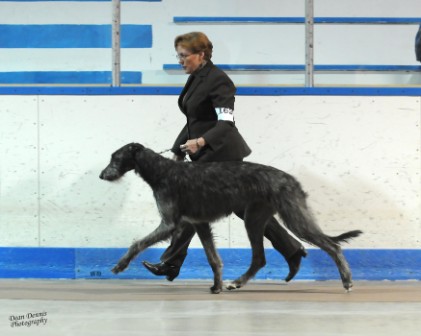A Little bit about the breed.....
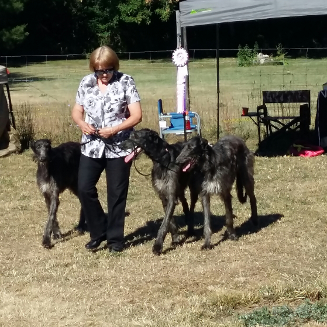
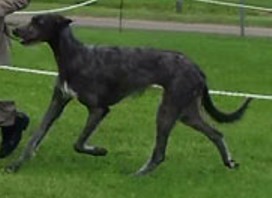
Rowan showing her stuff!!!
![illustrated_standard Scottish deerhound[1].pdf](classes/components/File/resources/images/pdf.png?1001125)
|
illustrated_standard Scottish deerhound[1].pdf Size : 4475.94 Kb Type : pdf |

|
Scottish deerhound CDN Standard.pdf Size : 43.084 Kb Type : pdf |
Whenever purchasing a Scottish Deerhound, always make sure you are buying from a reputable breeder. Please contact the Scottish Deerhound Club of America to insure the breeder is a member in good standing.

|
DH_OverviewCareReq.pdf Size : 1610.117 Kb Type : pdf |
Barbara Heindenreich of FernHill has put together the Deerhound Primer again to help individuals with their research into the breed.
Breed Description
The Deerhound resembles a larger, rough-coated Greyhound. As a companion they are loyal and gentle companion, obedient, quiet mannered, easy-going, faithful, affectionate, friendly and excellent with children, but a strong, swift, and formidable hunter.
Origin: An ancient breed, known centuries ago as the Scotch Greyhound, or Highland Deerhound is a member of the Sighthound family of hounds originated in Scotland. These ancient hounds are powerful, courageous and move with tremendous speed. They were used for the pursuit and killing of deer and during the medieval times only the very high ranking noblemen were allowed to own the Scottish Deerhound, which was also considered as the “Royal Dog of Scotland.” These exclusive ownership rules nearly led to the breed’s extinction until breeders revived the Deerhound in the early 1800s.
Height: From 30 to 32 inches (76-81 cm) for adult males at the withers, and Females from 28 and up (71 cm) at the withers. Rarely does the breed exceed this size, however extra size is no disadvantage when it is not acquired at the expense of symmetry, soundness and efficiency.
Weight: Males from 85 to 110 lb (39-50kg), Females 75 to 95 lb. (34-43 kg).
Appearance: A giant breed that resembles a larger rough-coated Greyhound. It is one of the tallest sighthounds, with a 3-4 inch long harsh, and wiry coat and mane that sheds very little. The beard and mustache, breast and belly are somewhat softer. His general appearance is well-balanced, harmonious and aesthetically pleasing breed. They should have a chest that is deep rather than broad. Coat colors include blue gray, gray, black, brindle or fawn with dark ears and a dark muzzle. Historically Deerhounds also could be seen with true brindle, yellow, and red fawn coats, or combinations.
The Deerhound has small, dark "rose" ears which are soft and folded back against the head unless held semi-erect in excitement. A white chest and toes are not objected to, and a slight white tip to the tail, however the less the better; a white blaze on the head or a white collar are disqualifying faults.
The head is long being broadest at the ears, skull flat, with little stop and a tapering muzzle. The eyes are dark, dark brown or hazel in color. The teeth should form a level, complete scissor bite. The long straight or curved tail, well covered with hair, should almost reach the ground.
Purpose: The Deerhound is a sighthound that was originally bred especially for deer hunting which required a combination of strength and speed necessary to chase and catch the Red Deer weighing as much as 250 pounds. In addition, they had to be able to run faster than the deer they were hunting. They usually hunted alone or in pairs and they have a keen sense of smell which has been used for tracking. In Australia Deerhounds have been used to hunt the Kangaroo and wild boar.
Temperament: The Deerhound is gentle, extremely friendly and sociable. The breed is famed for being devoted, docile, and eager to please, with a bearing of gentle dignity.
It is however a true sighthound which has been selected for generations to pursue game; consequently, most Deerhounds will be eager to chase. The Deerhound needs considerable exercise when young to develop properly and to maintain its health and condition. That does not mean it needs a large house to live in, however it should have regular access to free exercise in a fenced or otherwise "safe" area. Deerhounds should not be raised with access only to leash walking or a small yard, this would be detrimental to their health and development. Barbara Heindereich does a terrific job of describing the Deerhound temperament which can be found by going on the web at; http://www.fernhill.com/about-deerhounds/deerhound-character/.
"Dogs are not our whole life but they make our life whole." Roger Carras
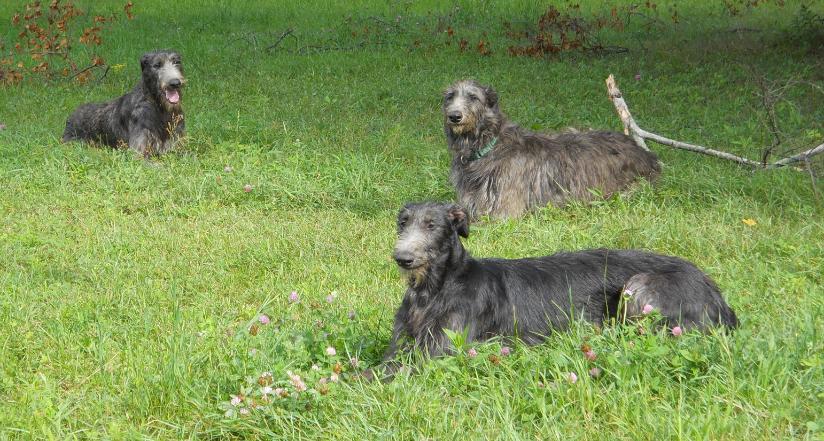
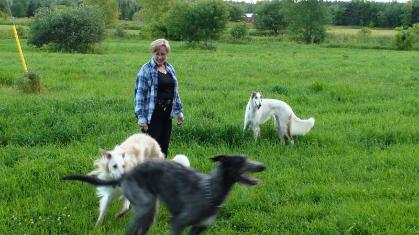
Running around and having fun!!!!!
